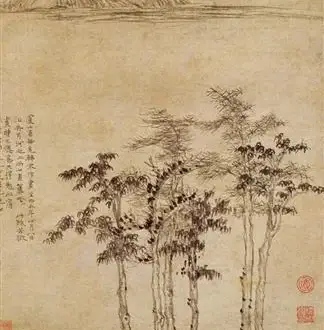Title of Artwork: “Six Gentlemen”

Artwork by Ni Zan
Year Created 1345
Summary of Six Gentlemen
Painting by the Chinese artist Ni Zan, who lived between 1301 and 1374. In this picture, there are six trees by a river. As the country was in turmoil and foreigners took over, virtuous gentlemen kept their moral selves away from each other. Was the first of Ni Zan’s paintings that showed off the stark, minimalist style that people know and love about him for. Six Gentlemen was a big moment in his art career. It was a big change. Later, he would often return to this subject matter, making many more works that were almost the same composition and style as the first ones.
All About Six Gentlemen
He painted Six Gentlemen while visiting his friend, the art collector Lu Heng, who had a passion for art. Ni Zan did this while he was visiting Lu Heng. NI wrote that he came to Lu’s house by boat on May 10.
He says that Lu brought paper and asked him to start painting right away (a request he made whenever the two of them met). Ni Zan did what he had to do, even though he was tired, even though it was hard. It took him a lamp to finish the painting.
So, there are only six old trees on a small bank, across a lot of water from a few hills that are a long way away. There was a note in the painting by Ni Zan that said that “old master Dachi,” an old and well-known artist, would laugh at the picture.
Notes from Huang, who was at Lu Heng’s house and saw the painting soon after it was done, are also there. Six gentlemen: Thank you very much. Note: The name comes from Huang.
Lu Heng’s house guest might have written this note. As a model for the painting, the person who wrote the note would be happy for Ni Zan to add a fisherman at some point. Paintings say that Huang and Ni Zan will live on for a long time because of them. After Huang died, this was added.
How Ni Zan feels about recent changes in the area around Wuxi, China, might be shown by a painting called Six Gentlemen. Because of the Yellow River flood last year, many people were forced to leave their homes and move to new places. This led to banditry and peasant uprisings, which were both bad things.
If you look at Ni Zan’s earlier paintings, Six Gentlemen has a more simple composition and brushwork than those. Some of these paintings were based on the styles of two artists who lived in China when they made them.
These artists were Dong Yuan and Zhao Mengfu. “What I call painting is nothing more than free brushwork done in a sketchy way,” Ni said later. “I never look for a representational likeness because I paint only for my own pleasure,” he added. Many people think that Ni’s brushwork is simple because he is said to be obsessed with cleanliness and purity, which makes his brushwork look simple.
They may have felt alone because the “six gentlemen” in the painting look like they’re alone. Mongol-led Yuan dynasty took over the native Chinese Song dynasty. This might be because they didn’t want to work for them. He had a group of people who were all in the same boat when he painted Six Gentlemen.
If Huang wrote this, it could be talking about that group, or it could be talking about the “six gentlemen,” a group of Song officials who were fired for their ideas. In late in the Yuan dynasty, the paintings of literati show a lot of attention to individual expression, both politically and artistically. They also don’t use a lot of information from the real world in their stories, though.
Information Citations
En.wikipedia.org, https://en.wikipedia.org/.























